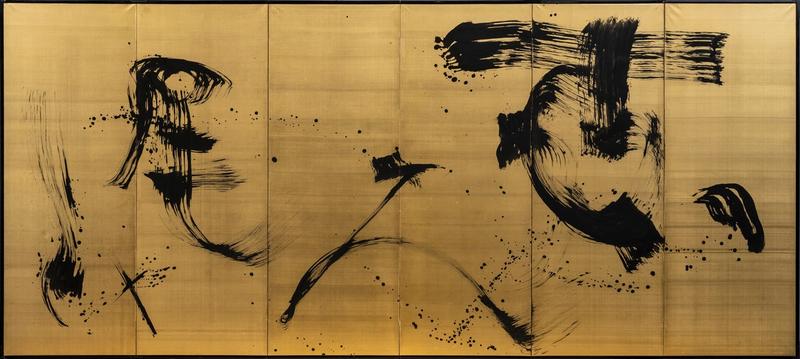“Kyo” (emptiness) by Suda Kokuta (1906-1990).
Ink and crayon on paper mounted as a triptych screen.
Signed Koku, dated 1986 and sealed Kokuta to lower left.
This unusual screen bears the key words that epitomise Suda Kokuta’s life and philosophy. The large, powerful calligraphic character “Kyo” in the centre means “emptiness” or “void”, a significant idea in Zen Buddhism that continuously influenced the artist throughout his life.
Other characters in crayon on both sides are the words he was particularly conscious of in his artistic and spiritual life as well as the names of priests and artists who inspired Suda. The words and names listed are:
Right panel:
Jōmon-jin
Jōmon people; people who lived in the Japanese archipelago during the Jōmon period (c. 14,000–300 BCE)
Wajin
The old name of the ethnic group of people who lived in the Japanese archipelago during the Yayoi period (300 BCE–300 CE)
Nihonjin
Japanese people
Eigaisei
Child-like quality
Kindai-zōkei
Modern form / art
Gendai-bijutsu
Contemporary art
Zōkei
Form, or art which takes some kind of form such as painting, sculpture, design and architecture
Busshitsu
Material
Shikaku
Square
Sen
Line
Men
Plane / two-dimensional
Shikimen
Coloured plane(s)
Rittai
Three-dimensional
Machiēru
Matière, texture
Obuje
Objet d'art
Zokushakai
The secular world
Taisei-kiyaku
Rules of structure
Datsuraku
Drop-out
Mujun
Contradiction
Ketsugō
Unify
Hitei
Denial
Seishin
Spirit / soul
Kyomu-shisō
Nihilism
Genjitsu
Reality
Shakai-taisei
Social system
Kachi-hyōka-shaki
Abandoning the appraisal value
Sai
Difference
Sonzai
Existence
Jittai
Substance
Saigyō
Saigyō Hōshi (1118-1190, Japanese), a famous poet, originally a worrier and later a travelling monk and hermit
Sesshū
Sesshū Tōyō (1420-1506, Japanese), a prominent master of ink painting and Zen Buddhism
Dōgen
Dōgen Zenji (1200-1253, Japanese), a Buddhist priest, philosopher, author of Shōbōgenzō (lit. “Treasury of the True Dharma Eye”)
Enkū
Enkū (1632-1695, Japanese), a Buddhist monk and sculptor who is known to have carved some 120,000 wooden Buddhist sculptures during his travels
Left-panel:
Sharaku
Tōshūsai Sharaku (act. 1794-1795, Japanese), an ukiyo-e print artist whose identify still remains a mystery
Bashō
Matsuo Bashō (1644-1694, Japanese), regarded as one of the most prominent poets of the Edo period and the greatest master of haiku
Hakuin
Hakuin Ekaku (1686-1769, Japanese), one of the most influential Zen priests and greatest Zen painters, revived the Rinzai school of Japanese Zen Buddhism.
Ryōkan
Ryōkan Taigu (1758-1831, Japanese), a monk of Soto School Zen Buddhism who was popular to children and commoners for his friendly and down-to-earth character. His simple poet and calligraphy works have been highly appreciated.
Kumagai Morikazu
Morikazu Kumagai (1880-1977, Japanese), an artist who is well-known for his iconic Fauvism-style painting.
Saeki Yuzō
Yūzō Saeki (1898-1928, Japanese), a western-style painter who was active mostly in Paris during his short artist life. His painting style is often associated with those of Maurice de Vlaminck and Maurice Utrillo.
Nihonjin-teki
Japanese
Reisei-teki
Spiritual
Jikaku
Consciousness
Chirei
Spirit of lands / Earth
Suijaku
Temporary manifestation of Buddha
Hyōi
Possession
Matoko(ou)fusuma
A sacred blanket that was mentioned in Nihonshoki (Chronicles of Japan, 720). Wrapping a prince with it was referred to as a proof of royal blood and descendant of kami (gods).
Dōji-mitchaku
Simultaneous cohesion
Shinreiteki-taitoku
Spiritual experience / mastering spirituality
Taiken
Experience
Kōdō
Action
Daichisei
Earth nature
Seimei
Life
Uchū
Universe
Seimeitai
Life form
Jittai
Substance
Seimei-kongen
The origin of life












